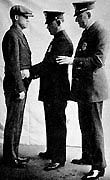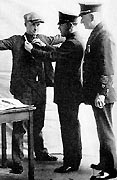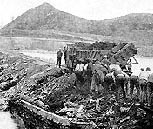| Return to Subheads List
Ambassador, Greeter
In 1944, President Roosevelt named Patterson as ambassador to the Yugoslav government. He first worked with exiled King Peter and then with Marshal Tito. The New Yorker was later also named ambassador to Guatemala and Switzerland.
  |
Commissioner Patterson's DOC annual reports included photos of his Prison Keepers School in action: Photo left was titled "The Wrong Way;" the other, "The Right Way." The captions read: "New keeper in Keepers' School being taught how to search prisoner." |
He was tapped in 1954 to chair Mayor Robert F. Wagner's Reception Committee, a post that eventually evolved into Chief of Protocol, Commissioner of Public Events and Commissioner of Commerce. For the next 12 years, Patterson was a highly visible member of Wagner's Cabinet, serving as the city's chief official greeter, welcoming and escorting dignitaries and celebrities, foreign and domestic, on their visits to the Big Apple.
Although he had come a long way from when he had worked as a day laborer in South Dakota mines, the Commissioner continued his membership in the miners union throughout his life. He not only retained the union card, he also kept faith with its spirit. As Correction Commissioner he sought and secured better pay and benefits for the keepers and matrons, listing the increase as "by far the most important accomplishment" and bluntly calling it "the first tangible indication that prison keepers have had for many years that their work was considered sufficiently hazardous and important to justify a living wage."
Little wonder then that a Correction union magazine proclaimed, "Commissioner Patterson has the honor of being the first Commissioner in the history of our Department who came out in the open, declaring himself in favor of organizing prison employees, advising them to band themselves into a national organization."
Return to Subheads List
Prison Keepers School
The Commissioner gave considerable prominence in his annual reports to what apparently was one of his favorite projects, the Prison Keepers School begun in 1927, the forerunner to the current Correction Academy. "The school for prison keepers . . . is the first of its kind in the United States," he wrote.
 |
Commissioner Patterson's annual report described how Rikers Farm inmates filled in a basin near the dumps. The image above is from a larger photo showing the project in progress. That and other photos relating to the school, the penitentiary and the farm appear on a Patterson Era Photo Page. |
"Since it was organized the State of Massachusetts has started such a school and just recently the Federal Government also inaugurated one which was patterned very closely after our own. In fact we furnished the government with much information concerning the curriculum and the method we use. . . .
"The course is an intensive one of eight weeks duration, half the day being devoted to instruction in various aspects of prison administration and the remaining half to physical training, drilling, swimming, jiu-jitsu, the handling of refractory prisoners and things of like nature. . . . We are having this curriculum printed in booklet form for distribution, as we have received many requests from prison officials throughout the country . . . nothing that the Department has ever done, at least in recent years, has excited such much widespread interest outside of New York.
"The school last year was held in the Police Academy and police instructors assisted our own men in the operation of the school. This year (1930), however, we have moved the school to a large room at the Penitentiary on Welfare Island and have placed it in complete control of our own officials. We are also working on a plan to take over the physical instruction of our men, hitherto given by members of the Police Department, so that we soon will be able to go 'on our own' in this department of the school as in others."
|
![[DOC Shield]](../gif/shld3.jpg)
![[Richard C. Patterson Bio]](../gif/rcpbio.jpg)
![[Richard C. Patterson]](../gif/rcpbio2.jpg)
![[DOC Shield]](../gif/shld3.jpg)
![[Richard C. Patterson Bio]](../gif/rcpbio.jpg)
![[Richard C. Patterson]](../gif/rcpbio2.jpg)
![[JATC cornerstone]](../gif/cornrst3.jpg)